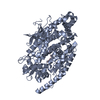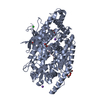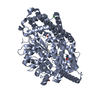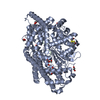| 登録情報 | データベース: PDB / ID: 8vjx
|
|---|
| タイトル | Structure of Human Neurolysin in complex with bradykinin peptide |
|---|
 要素 要素 | - Bradykinin
- Neurolysin, mitochondrial
|
|---|
 キーワード キーワード | HYDROLASE / metallopeptidase / bioactive peptides |
|---|
| 機能・相同性 |  機能・相同性情報 機能・相同性情報
neurolysin / regulation of skeletal muscle fiber differentiation / peptide metabolic process / negative regulation of cell adhesion / regulation of gluconeogenesis / negative regulation of blood coagulation / cysteine-type endopeptidase inhibitor activity / Intrinsic Pathway of Fibrin Clot Formation / negative regulation of proteolysis / peptide binding ...neurolysin / regulation of skeletal muscle fiber differentiation / peptide metabolic process / negative regulation of cell adhesion / regulation of gluconeogenesis / negative regulation of blood coagulation / cysteine-type endopeptidase inhibitor activity / Intrinsic Pathway of Fibrin Clot Formation / negative regulation of proteolysis / peptide binding / platelet alpha granule lumen / Peptide ligand-binding receptors / Post-translational protein phosphorylation / hormone activity / metalloendopeptidase activity / mitochondrial intermembrane space / vasodilation / Regulation of Insulin-like Growth Factor (IGF) transport and uptake by Insulin-like Growth Factor Binding Proteins (IGFBPs) / blood coagulation / Platelet degranulation / heparin binding / : / positive regulation of cytosolic calcium ion concentration / blood microparticle / G alpha (i) signalling events / G alpha (q) signalling events / positive regulation of apoptotic process / G protein-coupled receptor signaling pathway / endoplasmic reticulum lumen / inflammatory response / signaling receptor binding / mitochondrion / proteolysis / extracellular space / extracellular exosome / extracellular region / zinc ion binding / metal ion binding / plasma membrane / cytosol類似検索 - 分子機能 Neurolysin/Thimet oligopeptidase, N-terminal / Neurolysin/Thimet oligopeptidase, domain 2 / HMW kininogen / Kininogen-type cystatin domain / Kininogen-type cystatin domain profile. / Peptidase M3A/M3B catalytic domain / Peptidase family M3 / : / Peptidase M3A/M3B / Proteinase inhibitor I25, cystatin, conserved site ...Neurolysin/Thimet oligopeptidase, N-terminal / Neurolysin/Thimet oligopeptidase, domain 2 / HMW kininogen / Kininogen-type cystatin domain / Kininogen-type cystatin domain profile. / Peptidase M3A/M3B catalytic domain / Peptidase family M3 / : / Peptidase M3A/M3B / Proteinase inhibitor I25, cystatin, conserved site / Cysteine proteases inhibitors signature. / Cystatin domain / Cystatin-like domain / Cystatin domain / Cystatin superfamily / Metallopeptidase, catalytic domain superfamily / Neutral zinc metallopeptidases, zinc-binding region signature.類似検索 - ドメイン・相同性 |
|---|
| 生物種 |  Homo sapiens (ヒト) Homo sapiens (ヒト) |
|---|
| 手法 |  X線回折 / X線回折 /  シンクロトロン / シンクロトロン /  分子置換 / 解像度: 2.89 Å 分子置換 / 解像度: 2.89 Å |
|---|
 データ登録者 データ登録者 | Shi, K. / Aihara, H. |
|---|
| 資金援助 |  米国, 2件 米国, 2件 | 組織 | 認可番号 | 国 |
|---|
| National Institutes of Health/National Institute of Neurological Disorders and Stroke (NIH/NINDS) | R01NS106879 |  米国 米国 | | National Institutes of Health/National Institute of General Medical Sciences (NIH/NIGMS) | R35GM118047 |  米国 米国 |
|
|---|
 引用 引用 |  ジャーナル: Sci Rep / 年: 2024 ジャーナル: Sci Rep / 年: 2024
タイトル: Structural basis of divergent substrate recognition and inhibition of human neurolysin.
著者: Shi, K. / Bagchi, S. / Bickel, J. / Esfahani, S.H. / Yin, L. / Cheng, T. / Karamyan, V.T. / Aihara, H. |
|---|
| 履歴 | | 登録 | 2024年1月8日 | 登録サイト: RCSB / 処理サイト: RCSB |
|---|
| 改定 1.0 | 2024年8月21日 | Provider: repository / タイプ: Initial release |
|---|
|
|---|
 データを開く
データを開く 基本情報
基本情報 要素
要素 キーワード
キーワード 機能・相同性情報
機能・相同性情報 Homo sapiens (ヒト)
Homo sapiens (ヒト) X線回折 /
X線回折 /  シンクロトロン /
シンクロトロン /  分子置換 / 解像度: 2.89 Å
分子置換 / 解像度: 2.89 Å  データ登録者
データ登録者 米国, 2件
米国, 2件  引用
引用 ジャーナル: Sci Rep / 年: 2024
ジャーナル: Sci Rep / 年: 2024 構造の表示
構造の表示 Molmil
Molmil Jmol/JSmol
Jmol/JSmol ダウンロードとリンク
ダウンロードとリンク ダウンロード
ダウンロード 8vjx.cif.gz
8vjx.cif.gz PDBx/mmCIF形式
PDBx/mmCIF形式 pdb8vjx.ent.gz
pdb8vjx.ent.gz PDB形式
PDB形式 8vjx.json.gz
8vjx.json.gz PDBx/mmJSON形式
PDBx/mmJSON形式 その他のダウンロード
その他のダウンロード 8vjx_validation.pdf.gz
8vjx_validation.pdf.gz wwPDB検証レポート
wwPDB検証レポート 8vjx_full_validation.pdf.gz
8vjx_full_validation.pdf.gz 8vjx_validation.xml.gz
8vjx_validation.xml.gz 8vjx_validation.cif.gz
8vjx_validation.cif.gz https://data.pdbj.org/pub/pdb/validation_reports/vj/8vjx
https://data.pdbj.org/pub/pdb/validation_reports/vj/8vjx ftp://data.pdbj.org/pub/pdb/validation_reports/vj/8vjx
ftp://data.pdbj.org/pub/pdb/validation_reports/vj/8vjx リンク
リンク 集合体
集合体
 要素
要素 Homo sapiens (ヒト) / 遺伝子: NLN, AGTBP, KIAA1226 / 発現宿主:
Homo sapiens (ヒト) / 遺伝子: NLN, AGTBP, KIAA1226 / 発現宿主: 
 Homo sapiens (ヒト) / 参照: UniProt: P01042
Homo sapiens (ヒト) / 参照: UniProt: P01042 X線回折 / 使用した結晶の数: 1
X線回折 / 使用した結晶の数: 1  試料調製
試料調製 シンクロトロン / サイト:
シンクロトロン / サイト:  APS
APS  / ビームライン: 24-ID-E / 波長: 0.97918 Å
/ ビームライン: 24-ID-E / 波長: 0.97918 Å 解析
解析 分子置換 / 解像度: 2.89→96.56 Å / SU ML: 0.37 / 交差検証法: FREE R-VALUE / σ(F): 1.34 / 位相誤差: 27.56 / 立体化学のターゲット値: ML
分子置換 / 解像度: 2.89→96.56 Å / SU ML: 0.37 / 交差検証法: FREE R-VALUE / σ(F): 1.34 / 位相誤差: 27.56 / 立体化学のターゲット値: ML ムービー
ムービー コントローラー
コントローラー







 PDBj
PDBj












